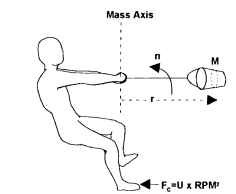3.14.4
What doesn’t move does not need balancing.
According to Newton’s laws, a body in motion tends to move in a straight line unless acted on by an outside force that causes it to deviate from its normal course. In the case of rotating bodies, a particle on the outside travels on a course tangent to the rotation of the body. Centripetal force acts on the particle to accelerate it while the particle is attached to the rotor toward the center of rotation. If the rotor is balanced, then there is an apparent even distribution of mass. However, if there is an excess of mass concentrated at one location on the rotor (i.e., an unbalance), the rotating mass attempts to force the unbalanced portion in a tangential direction, thus causing vibration and fatigue of the components. Rotational motion is different from straight-line motion. An automobile’s acceleration stops when it reaches a constant speed. Turning a corner causes an instant acceleration even if the speed does not change; thus, acceleration is generated through the vehicle’s tires. An unbalanced rotor experiences constant acceleration reacted through the bearings because the direction of the force is constantly changing. The velocity of the unbalanced mass is proportional to the speed, rpm, and the acceleration is proportional to the rate of change of the velocity, (rpm)2. Components of centripetal force are the following:
• Mass (volume)
• Radius (distance)
• Velocity (speed)

FIGURE 3.93 Components of centripetal force.
As an example, Fig. 3.93 shows a weight (mass) attached to a 3-ft string (radius) and twirled in a circle at 60 rpm (velocity). A greater mass produces a greater force, a longer string produces a greater force, and a faster speed produces a greater force proportional to the square of the speed.
Unbalance is independent of rotational speed and will not increase or decrease when standing still. At zero speed, the unbalance has no effect on the rotor. However, if the rotor is rotated, the unbalance will exert centripetal forces, causing vibration that becomes more violent as the speed increases. Centripetal force increases
proportionately to the square of the speed increase. At double the speed, centripetal force quadruples; triple the speed and the force is nine times as much.
Centripetal Force (Electric Motors)
Next post: Types of Balancing Machines (Electric Motors)
Previous post: Resonance (Electric Motors)
